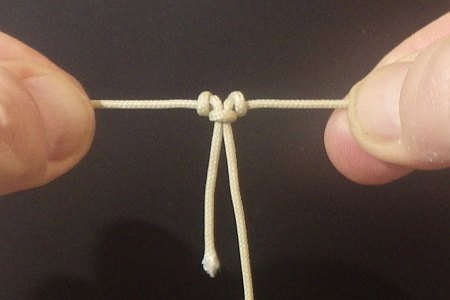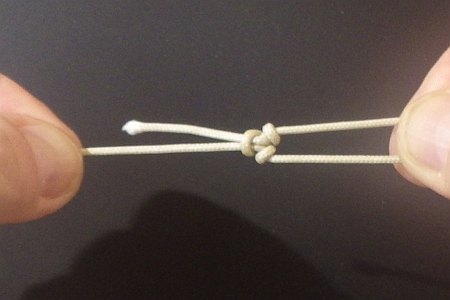- Home Page
- Kiting Knots
- Prusik Knot
The Prusik Knot
And Its Kiting Applications
The Prusik knot: Where would kite fliers be without this great shiftable, lockable knot. It's a bit of a pain to tie at first, but then adjusting a bridle becomes so easy!
Pulling the bridle straight unlocks the knot, letting you shift it along the bridle line. Pulling on the lines in pairs causes the knot to fold, locking it in place.
I use the Prusik on horizontal bridle loops to shift the knot left or right across the kite for trimming purposes. More commonly, it's also used to slide up and down the bridle line of, say, a diamond kite to adjust the towing point fore and aft.
There are other ways, some possibly a little simpler, to obtain a shiftable knot. However, the Prusik has worked so well for me over the years that it's the one I would recommend.
The photo immediately below shows the knot not quite fully tight, for clarity:
 Prusik knot
Prusik knot
On this site, there's more kite-making info than you can poke a stick at. :-)
Want to know the most convenient way of using it all?
The Big MBK E-book Bundle is a collection of downloads—printable PDF files which provide step-by-step instructions for many kites large and small.
That's every kite in every MBK series.
Prusik Knot
 1. Over the back and down
1. Over the back and down 2. Around once more
2. Around once more 3. Across and over
3. Across and over 4. Back up behind
4. Back up behind 5. Around and through
5. Around and through 6. Down and through
6. Down and through 7. Pull both strands tight, slide across if necc.
7. Pull both strands tight, slide across if necc. 8. Pull all four strands to lock
8. Pull all four strands to lockOn kites with four-leg bridles, arranged as an upper and lower loop plus a connecting line, this means three shiftable knots. For example, the Dowel Rokkaku and Dopero. At least you only have to tie these knots once.
Although it seemed a little excessive at the time, I took this approach on even my smallest dopero. This is a tiny kite with a 30 cm (12 in.) wingspan. But it sure paid off, since some fiddling was required to get a decent flight out of it!
Later, I also used this knot on the vertical bridle loops of a large genki. It was the same deal; tiny adjustments can trim the kite left or right.
This mountaineering knot was invented in 1931 by Dr. Karl Prusik—with one "s." At least this
webmaster has finally got it right. Many others still haven't! Prusik
later authored a mountaineering manual, which was the first publication
to feature this now well-known sliding knot.
Tying a Prusik knot actually becomes enjoyable after a while, funnily enough! Be sure to put a Figure Eight knot into the short end of the line though, since constant use tends to pull line through the knot. The short end gets noticeably shorter than you remember tying it originally. Perhaps this happens during locking and unlocking.
As mentioned earlier, there's more kite making on this site than you can poke a stick at. :-)
Want to know the most convenient way of using it all?
The Big MBK E-book Bundle is a collection of downloads—printable PDF files which provide step-by-step instructions for many kites large and small.
That's every kite in every MBK series.
